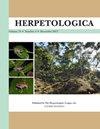斯里兰卡Fowlea Theobald属水蛇的系统学1868(爬行纲:自然科)
IF 1.1
3区 生物学
Q2 ZOOLOGY
引用次数: 1
摘要
摘要:根据系统发育和形态学特征,我们对斯里兰卡纳氏Fowlea属的系统学进行了修订,该属包括两个形态种。斯里兰卡种群的分类学长期以来一直存在争议,其中一个物种十多年来一直被列为Xenochrophis cf.piscator。尽管斯里兰卡种群在形态上与印度的Fowlea piscator有亲缘关系,但它们在基因上与印度东部的F.piscator senso有着9.9-12.3%的p距离,与印度西南部的Fowlera物种有着高度的差异,线粒体细胞色素b基因的p距离为4.9-11.1%。在这里,我们复活了Müller(1887)的变种,Tropidonotus quincucciatus var.unicolor,作为一个独特的分类单元,将其提升到物种水平,并将其归入Fowlea属。因此,到目前为止被公认为X.cf.piscator的种群将在下文中被视为F.unicolor,我们重新定义了它和它的正模(通过单型)。我们暂时将该物种限制在斯里兰卡,并说明在印度南部也有种群的可能性。第二个不同的物种,Fowlea asperima,是斯里兰卡的特有物种,长期以来一直与它的同域同源物,F.unicolor comb混淆。11月,我们指定了一个选型并在本文中重新表述。目前,Fowlea属的九个物种已经被识别,但可能还有更多的物种(包括那些被视为主观同义词的物种)尚未被识别。本文章由计算机程序翻译,如有差异,请以英文原文为准。
Systematics of the Sri Lankan Water Snakes of the Genus Fowlea Theobald 1868 (Reptilia: Natricidae)
Abstract: Based on phylogenetic and morphological characters, we revise the systematics of the natricid genus Fowlea in Sri Lanka, comprising two morphospecies. The taxonomy of the Sri Lankan populations has long been controversial, and one of the species has, for more than a decade, been listed as Xenochrophis cf. piscator. Although the Sri Lankan populations are morphologically allied to Fowlea piscator in India, they are genetically highly divergent from the eastern Indian F. piscator sensu lato with a p-distance of 9.9–12.3%, and from southwestern Indian Fowlea species with a p-distance of 4.9–11.1% in the mitochondrial cytochrome b gene. Here, we resurrect Müller's (1887) variety, Tropidonotus quincunciatus var. unicolor, as a distinct taxon, elevate it to the species level, and assign it to the genus Fowlea. Therefore, the population so far recognized as X. cf. piscator will be treated hereafter as F. unicolor and we redescribe it and its holotype (by monotypy). We tentatively restrict this species to Sri Lanka and state the possibility of a population in southern India too. The second distinct species, Fowlea asperrima, which is endemic to Sri Lanka, has long been confused with its sympatric congener, F. unicolor comb. nov., and we designate a lectotype and redescribe it herein. Currently, nine species of the genus Fowlea are now recognized, but it is likely that further species (including those regarded as subjective synonyms) remain unrecognized.
求助全文
通过发布文献求助,成功后即可免费获取论文全文。
去求助
来源期刊

Herpetologica
生物-动物学
CiteScore
4.60
自引率
0.00%
发文量
27
审稿时长
>12 weeks
期刊介绍:
Established in 1936, Herpetologica is a quarterly peer-reviewed journal serving herpetologists, biologists, ecologists, conservationists, researchers and the scientific community. The journal contains original research papers and essays about the biology of reptiles and amphibians, and covers many relevant topics including: behavior, conservation, ecology, genetics, morphology, physiology and taxonomy.
 求助内容:
求助内容: 应助结果提醒方式:
应助结果提醒方式:


